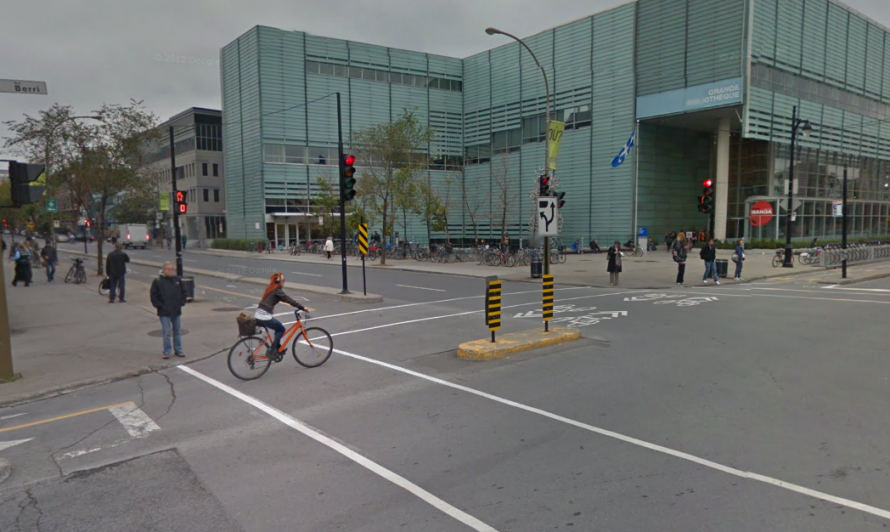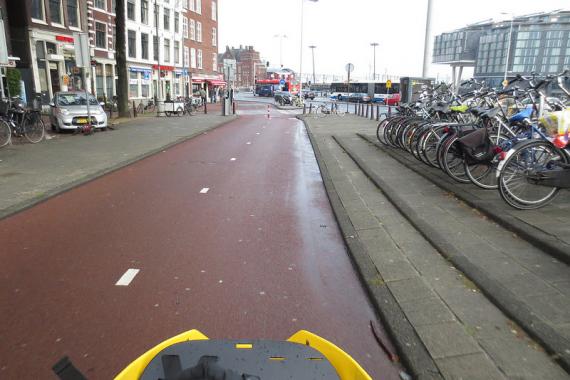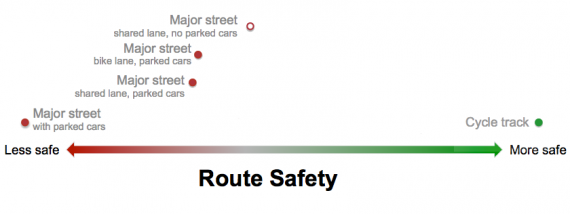
Are two-way (or bidirectional if you prefer) protected bike lanes "dangerous"? Some of the opposition to the Harbord proposal are fomenting fear and doubt by claiming as much. There's even a "No Danger Lanes" facebook page decrying the bidirectional for Harbord.
Let's put this question a different way. Has there been an uproar in Montreal about death and destruction because of their plentiful bidirectional bike lanes? Has there been a bloodbath that we've been ignoring?
I might have missed something but I think not. Montrealers seem to be plenty angry at their corrupt mayors but when it comes to their bidirectional cycle tracks (aka protected bike lanes), the overwhelming majority of people seem to be happy and there's been no outcry of cyclists getting injured on them in great numbers.
And Montreal isn't alone. Cycling nirvanas like Amsterdam also have bidirectional cycle tracks and the people seem to be happy with them, or at the very least accepted them.

A bi-directional path. Photo: Mikael Colville-Andersen.
So let's use some common sense. Two-way cycle tracks are not dangerous. They are safe and people are comfortable with them.
Is this a bloodbath you were looking for?
You might say, "Well that's all well and good but what about this Montreal blogger who seems to have discovered the dangers of Montreal bidirectional?"
Let's take a look.
This Montreal blogger is David Beitel who made a claim that the cycle tracks in Montreal have an "elevated risk" of cycling accidents. He pointed out that two of the cycle tracks had the second and third highest number of accidents between cyclists and drivers in Montreal out of all streets.
You might exclaim: holy crap, why are all these cyclists getting injured on cycling infrastructure? Let's rip it all out!
But let's not get carried away. Beitel falls for a common error: he provides absolutely no context to the data; no denominator to put his data into proper perspective. The denominator we need here is the number of people cycling on each street.
Without a denominator of the cycling traffic volume, we might as well just conclude that riding on a highway like the Gardiner Expressway is the safest. Highways typically have very few cycling crashes. But they also usually have next to zero cyclists using them. Because it's illegal.
Beitel's approach cannot avoid absurd conclusions.
When we take into account cycling traffic volumes we would find that the cycle tracks in Montreal, such as De Maisonneuve and Berri, are actually not dangerous at all. When cycling traffic increases we will typically see some uptick in the number of car-bike collisions. And we realize that even though a highway may have zero cyclist colliding with drivers, it might be because there were no cyclists there.
So Beitel's conclusions are junk and anyone here in Toronto who references Beitel as "proof" of the danger of bidirectional is plain wrong. If you're curious you can read a bit more about this in the Evidence Training Guide created for cycling educators by the Cycling in Cities group at the University of British Columbia (particularly pages 2, 3 and 43 in the sidebar).
Bidirectional cycle tracks are probably safer
Of the scientific evidence we do have, we could make a safe bet that 1) bidirectional cycle tracks are probably safer than riding on the road and 2) cycle tracks in general are safer than bike lanes.
In a study headed up by Harvard's Dr. Lusk, it found that Montreal's two-way cycle tracks were shown to be "either lower or similar injury rates compared with bicycling in the street without bicycle provisions".
Lusk found that Rue Berri (as pictured above) had a lower risk (0.48) than the reference street of Denis. Reference streets are always considered to be 1 for comparison purposes. Being below one means a street is safer than the reference.
Overall, the study found that the cycle tracks they studied (all of which were bidirectional) had a 28% lower injury rate. Lusk concluded that their "results suggest that two-way cycle tracks on one side of the road have either lower or similar injury rates compared with bicycling in the street without bicycle provisions. This lowered risk is also in spite of the less-than-ideal design of the Montreal cycle tracks, such as lacking parking setbacks at intersections, a recommended practice."
Cycle tracks (one and two-way) are safer than the road
Cycle tracks in general are safer than both riding on the road or even riding in a painted bike lane. The following diagram from UBC's study of injuries and bike infrastructure describes it well:

Cycle tracks beat all the other options for on-road infrastructure by a mile.
Where possible, build unidirectional otherwise bidirectional works
This all being said, the cycling infrastructure guides are now usually recommending unidirectional over bidirectional. Vélo Québec's Planning and Design for Pedestrians and Cyclists, for instance, says (p. 80):
"On-road bike paths should preferably be unidirectional. Bi-directional paths offer effective safety between intersections but complicate traffic at intersections. In fact, they increase the number of conflict points between bicycles and turning vehicles."
"Preferable" but not always possible.
This is fine in an ideal world. But we live in a world with physical and political constraints. We don't have the political sway to force politicians to ignore merchants and take out all the parking on any of our major arterials. Bidirectional is seen as a compromise: cyclists get something safer, more comfortable and merchants get to keep some on-street parking. For instance, Councillor Vaughan has publicly stated that on Harbord it is bidirectional or nothing:
“The bi-directional protects the parking that is needed,” says Vaughan. When asked for specific numbers his assistant helps out: “Right now there are 48 parkings spots – and with the bi-directional plan, we are trying to salvage 95 to 98 per cent of parking.” The unidirectional plan would take out all of the on-street parking.
“If the choice is bi-directional or nothing then bi-directional is safer,” says Vaughan.
So we are fighting for bidirectional on Harbord and possibly on more streets in the future with similar constraints. And we will work with traffic planners and the community to make them as safe as possible. There are number of tools at the planners' disposal: separate light phases, improved sightlines, markings through the intersections, signage, bump-outs and so on.
References
- Bicyclists' Injuries & the Cycling Environment ("the BICE Study"), Cycling in Cities, University of British Columbia
- Lusk, A., Furth, P., Morency, P., Miranda-Moreno, L., Willett, W., Dennerlein, J. (2010). Risk of injury for bicycling on cycle tracks versus in the street. Injury Prevention.
- Evidence Training Guide by Cycling in Cities, University of British Columbia.

Comments
Ben
Cyclists have to fight for
Thu, 11/07/2013 - 10:43Cyclists have to fight for every ounce of protected infrastructure we get. No one is going to come along and make strides to make cycling safer across the whole city. So I question the logic in bolstering an area that already has cycling infrastructure when there are bad spots all over the city that need addressing.
I'm not against putting bi-directional lanes on Harbord ever, I just think that right now the effort of doing so could be applied for more gain elsewhere. When you a cyclist heading west on Harbord gets to Ossington, they are left in a bad position.
Why not put in a stop light at Hepbourne, (at least) sharrows on Ossington (at least) between College and Hallam, and some indirect left turn blocks here and there? It seems like this would do more to serve the safety of cyclists than the bi-directional lanes.
I'd rather have an expansive system of good enough, rather than great in one place and terrible everywhere else. I don't think that any cycling advocate who has been paying attention in Toronto would think that isn't the decision we're facing. And I feel that the bike union has made the wrong choice.
herb
Your response is off-topic
Thu, 11/07/2013 - 11:10Your response is off-topic Ben. This post is about the fear-mongering that's been going on about bidirectional. Not about whether to built infrastructure on Harbord or put it elsewhere. This has been discussed ad nauseum elsewhere on this blog.
selkie (not verified)
I thought I had died and gone
Thu, 11/07/2013 - 11:40I thought I had died and gone to heaven several years ago when I brought my bike to montreal to visit a friend. With the exception of intersections here and there (which were fine as they had lights) I was able to start basically at the Ortatory on the Mountain and follow super safe, comfortable, separated bike lanes from there to the Lachine Rapids. The bi-directional ones work like a dream - and far better for pedestrians, cyclists and cars. People forget what a lot of stress it takes off cars to have bikes safely on the other side of a cement barrier!
Ben
Fair enough Herb. I don't
Thu, 11/07/2013 - 11:59Fair enough Herb.
I don't doubt that bi-directional protected lanes offer increased safety over painted lanes and uni-directional separated lanes. People on my side of this debate may have made some invalid points about the safety of bi-directional lanes, which you have done a good job of debunking here.
I should have qualified that my comment was meant in the wider context of the bi-directional lane on Harbord debate. Sorry for breaking netiquette.
You have refuted one argument here, but it's far from clear that bi-directional lanes on Harbord are the best use of resources for making the city a better place for cyclists.
Seymore Bikes
@ Ben While there is surely
Thu, 11/07/2013 - 17:31@ Ben
While there is surely room for subjective conjecture about what is "best" for cycling, there is plenty of data to support bi-directional bike lanes.
And, to clarify, Cycle Toronto isn't putting the lanes on Harbord, the city is.
Seymore Bikes
I rode on De Maisonneuve
Thu, 11/07/2013 - 17:25I rode on De Maisonneuve recently and found the lanes to be a great benefit for cyclists. There are intersections to negotiate of course, but I got the feeling that everyone was (by now) rather familiar with the mixing of cars, pedestrians & bikes.
Mark2 (not verified)
I'm surprised that there was
Thu, 11/07/2013 - 18:07I'm surprised that there was no mention of Vancouver's bidirectional cycle tracks here. For the most part they work really well, but they did require some extra connecting infrastructure and bike specific signalling to fit in with the existing roads.
The only big issue with them I've seen is that when implemented on a one way road (Dunsmuir), the signals are timed up for car traffic, so when going against the car traffic in the cycle lane you hit a lot of reds.
I'd still rather ride on a protected bidirectional with a bunch of stops than ride in traffic though!
Some pics on here: http://spacing.ca/vancouver/2011/07/25/vancouvers-hornby-and-dunsmuir-se...
David (not verified)
I think you actually have
Thu, 11/07/2013 - 20:43I think you actually have missed something.
From what I can tell, most, if not all, of Montréal's on-street bidirectional bikeways are placed on one-way streets, and on the left hand side at that. So, in effect what you have is a two-way street that is bikes-only in one direction and all traffic in the other direction, with the two bike lanes placed next to each other.
What that means is that motorists have a virtually unobstructed view of all cyclists they are likely to encounter, as is the case for cyclists vis-à-vis cars.
But if you place a bidirectional bikeway on one side of a standard two-way street, you create a serious risk for collision between motorists making a left turn from the side without the bikeway as their view of same direction cyclists is obstructed by the opposite direction car lane.
I haven't been to Montréal in awhile, but from what I remember I just don't recall seeing bidirectional bikeways on two-way streets. I further note that Harbord is a two-way street, so unless the bidirectional bikeway proposal is linked to a proposal to turn Harbord into a one-way street for all other traffic, then the comparison with Montréal's bidirectional bikeways really isn't valid.
herb
Hi David, haven't missed
Fri, 11/08/2013 - 11:18Hi David, haven't missed that. There are, in fact, bidirectional cycle tracks on Montreal two-way streets. Rue Berri in the above photo is a two-way street. And there are others.
We've even got good examples in Toronto. The Lakeshore and Eglinton (and the new Queens Quay bidirectional) are examples of bidirectional on two-way streets. They all have the same challenge of dealing with intersections. None of them seem particularly dangerous.
The intersections are a concern but without data we're just speculating about the relative risk. Remember that to be fair you need to compare with our actual streets which typically expose cyclists to dangers of overtaking collisions and dooring. So we can't assume that we know what is a greater danger.
What we do know I've already covered in the post.
And even with data the mitigation measures are not predetermined. It doesn't mean we have to rip the whole thing out. There are ways to improve bidirectional cycle tracks - as mentioned in the Ontario manual for instance. The intersections can be improved. Anything from chevrons, green paint, separate signal phases to the highest Dutch standards with bulb-outs to force cars to slow down and carefully turn. There are lots of options.
Charles Lidstone (not verified)
The Lakeshore
Sat, 11/09/2013 - 04:38> The Lakeshore and
Personally, I find the Lakeshore trail/bikeway to be pretty bad at Leslie and at Carlaw. Not to mention they've decided to neuter its usefulness around the mall driveways. Surely they wouldn't have put in those stupid 'bicycle calming' diversions if they didn't have a lot of problems at those spots..
It isn't a fair comparison though.. Lakeshore has high posted speed limits and cars operate in a suburban style that is hostile to cycling. Harbord has low posted limits and cars operating in a downtown mode that is fairly accommodating of cycling.
The real question.. Is the bikeway supposed to be Ossington all the way to Yonge? How will it get across Queens Park?
Kevin (not verified)
Meanwhile, in Hamilton, a
Sun, 11/10/2013 - 07:15Meanwhile, in Hamilton, a high-class bi-directional protected bike lane was just approved for a major East-West artery. See:
https://www.raisethehammer.org/article/1949/a_yes_we_cannon_victory_is_a...
Kevin Love
Clark in Vancouver (not verified)
The two-way separated lanes
Mon, 11/11/2013 - 02:23The two-way separated lanes in Vancouver work very well and there haven't been any problems.
Car culture is so pervasive and some motorists feel so entitled that it's politically very difficult to remove car parking on both sides of a street. Since a separated cycle track has to be just as wide even if it's one-way (to allow for passing) it might as well be two-way.
There are a few one-way separated lanes in Vancouver here and there, all short. Mostly just to fill in gaps in the network. I see people using them both ways so either they don't know they're one-way or they have a need that can only be fulfilled by treating them as two-way.
If it's a first ever for Toronto, maybe suggest a trial. Then everyone can stop fretting about the unknown and can see for themselves that it's fine. Once it's done once in a city, it can then be done again without so much opposition. Doing a trial can reduce worry as you can say that it can be removed if it doesn't work out.
And merchants will be fine. Everywhere in the world that a separated lane has been put in, the merchants benefitted.
W. K. Lis
In the 1950's, I remember
Tue, 11/12/2013 - 09:54In the 1950's, I remember riding my bicycle in the opposite direction on one way streets. No problem. Even passing police cars. No problem. Stop signs were for cars. Again no problem.
Today, the car culture dictates that every non-automobile user must follow the leader. Bicycles are a problem.
anthony
Sure, on-street BiDi bike
Tue, 11/12/2013 - 10:54Sure, on-street BiDi bike lanes work well enough, but:
Uni-directional separated bike lanes safest
By SPOKES Dunedin on Tue, 12 Nov 2013
This post is by Dr. Hank Weiss, an injury epidemiologist with over 3 decades experience in injury prevention research and practice, and a SPOKES member.
Properly designed uni-directional separated/protected bike lanes are the safest on-road design when they cross driveways and intersections
JoeFresh557 (not verified)
Can we please make some noise
Tue, 11/12/2013 - 13:40Can we please make some noise and get the Harbord-Hoskin bi-directional lane extended to Wellesley. They are putting uni-directional lanes here which baffles me. I hate the Sherbourne lanes.
Separatist (not verified)
Wellesley to Yonge Street
Tue, 11/12/2013 - 18:00Wellesley to Yonge Street from Parliament has been scheduled to proceed soon with construction, maybe this fall/next few weeks.
Has anyone seen any progress has it started?
Separated cycle track Wellesley from Parliament through Queens Park to Hoskins and St George is approved and all to be completed by next year.
There isn't an approval yet for Hoskins from St George to Harbord at Ossington. Will come up before City council for approval in February or March, City staff claim.